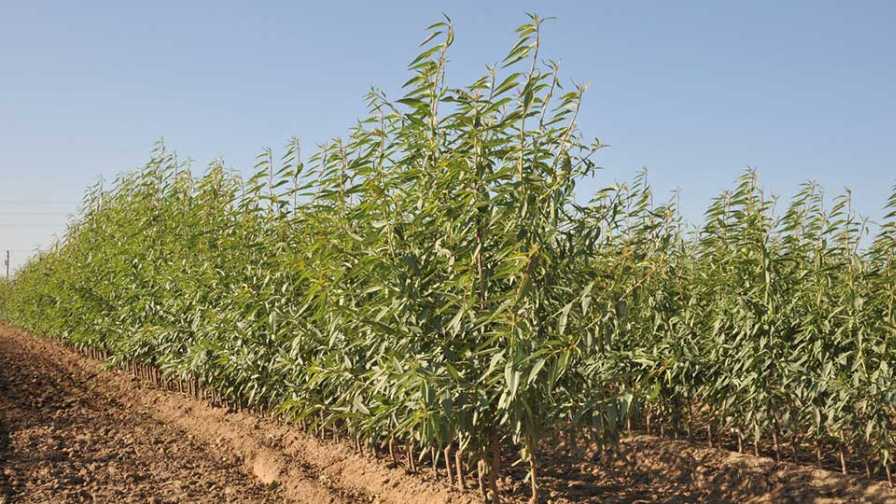Pollinating Varieties or No Pollinating for Almond Growers?

The bare root division of Dave Wilson Nursery in Hickman, CA, procures stock from its bareroot nursery row, which includes bareroot almond trees (shown here) that will be harvested this winter for commercial almond growers.
Photo courtesy of Dave Wilson Nursery
Asked what the most pressing need growers have in regard to tree nut variety selection as we head into 2021, the pollination question came up most often in discussing the most dominant nut, almonds.
Brent Burky, Sierra Gold Nurseries Director of Sales, says smart growers are choosing a balanced portfolio of almond varieties.
“The industry standard, ‘Nonpareil’, planted with several different pollinizer options, is still the market leader, so growers always want to have a good percentage of their acreage committed to the top-paying ‘Nonpareil’ variety,” he says.
However, Burky notes that the choice for growers isn’t as simple as it used to be.
“The new self-fertile varieties have proven to be highly productive and very efficient to farm, thus earning a percentage of most almond growers’ acreage,” he says. “The top, self-fertile almond varieties are currently ‘Independence’ and ‘Shasta’.”
‘Independence’ was developed by Zaiger Genetics of Modesto, CA, and was the first commercially successful self-fertile variety. It is available from Dave Wilson Nursery. Noah Tarry, Dave Wilson Nursery Market Development Specialist, says they leave such decisions up to growers.
“Most growers choose varieties based on what processors are looking for and what is trending in the market,” he says. “The focus is usually on what is going to give them the best return on investment.”
‘Shasta’ is available from Burchell Nursery, and the nursery’s owner/CEO Tom Burchell says deciding on whether or not to plant a self-fruitful variety is the first consideration a grower should have. It involves answering a lot of questions, he emphasizes.
“Do you want to have to buy a pollinator? What does it cost to harvest twice versus the cost of harvesting once? What are your pollination costs?”
Burchell says all these questions, and probably a few more, need to be answered before varietal selection. And he notes that growers obviously have to take processors’ needs into consideration.
“Some want small nuts, some large, some in-shell, some shelled. It depends on what a handler wants,” he says. “I don’t want to tell growers what to do, but they need to decide whether or not to pull out that old orchard and replant with a self-fruitful variety that could be more productive.”
PISTACHIOS AND PECANS
There are many other considerations when it comes to selecting almond varieties. Sarah Paris, Research and Product Development Manager, Fowler Nurseries, notes that some of their Northern California growers have expressed concern about the leafing out issues with the popular ‘Monterey’ variety.
No one knows what’s causing the problem, which was first termed “leafing failure” when it emerged on a widespread basis a couple years ago. Paris says the problem got so severe this past spring that many growers voice skepticism about continuing to plant ‘Monterey’.
“The best-case scenario is that some actionable insights come out of the UC (University of California) research in the near future,” she says. “If we can understand why this is happening — and how to potentially mitigate it — I think growers will feel more comfortable continuing on with this popular pollinizer.”
On the other side of the country, David “Farmer Dave” Hughes, owner of Rock Bridge Co. in Bethpage, TN, says in pecans the key is the availability of appropriate scab-resistant varieties. He says more research needs to be done, and it’s tough to be optimistic, but he’s doing his best to supply growers.
“The biggest challenge that I don’t have control over is that our state and federal breeding and Extension support is going away,” he says. “What I do have control over is increasing the numbers of the varieties that are in demand right now.”
Back in California, the other nut that is receiving a lot of attention these days is pistachios. For example, in Kern County, one of the largest nut-producing counties in the U.S., almond acreage actually decreased slightly while pistachios continued their upward climb. One big advantage pistachios have over almonds is their ability to tolerate saltier soils.
Sierra Gold’s Burky says most pistachio growers are choosing the new UC-released varieties ‘Golden Hills’ and ‘Lost Hills’.
“Both of these varieties are earlier than the industry standard ‘Kerman’, so growers get to start harvest earlier,” he says, “and these new pistachio varieties look to have greater yields with a higher percentage of split, edible nuts.”
Whatever variety a grower chooses, Burchell says they’d be advised to take his dad’s advice to not move too hastily, because it always takes at least 10 years to prove a given variety.
“Of course, it’s the grower’s decision,” he says. “But take advice from your nursery, your farm advisor, anywhere you can get it.”









